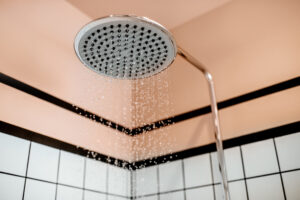Radiant floor heating is an advanced solution that delivers consistent warmth by turning a building’s entire floor into a quiet, draft-free heat source. Unlike traditional forced-air systems, this method eliminates cold spots and circulates less dust, creating a healthier and more comfortable environment. Valued by homeowners for its luxurious underfoot comfort and by property managers for its energy savings and reliability, in-floor heating is a versatile and modern choice.
This guide explains the basics, advantages, costs, and crucial factors to consider when choosing an in-floor heating system. Additionally, we will delve into the installation process, maintenance best practices, comparisons with traditional heating methods, and emerging trends in the industry.
How In-Floor Heating Systems Work
In-floor heating systems deliver heat directly through the floor and upward, rather than relying on air circulation. There are two primary types:
Electric vs. Hydronic Systems
- Electric In-Floor Heating: Uses heating cables or mats installed beneath the floor. This option is ideal for small-scale applications like bathrooms or kitchens due to its simple installation and lower initial cost.
- Hydronic In-Floor Heating: Employs a network of tubes through which heated water circulates. Powered by a boiler or water heater, hydronic systems are often more energy-efficient for larger areas and offer significant long-term savings. It is important to note, however, that while hydronic systems can lead to lower monthly energy bills in heating-dominated climates, they do require periodic maintenance.
Both types provide uniform heat distribution, eliminating the unevenness often found in traditional heating systems. Effective integration requires careful consideration of flooring materials and any necessary subfloor preparation. You can explore additional details on integration and flooring by visiting our residential plumbing details.
Advantages of In-Floor Heating Systems
Radiant floor heating offers several key benefits that extend beyond simply warming a room:
Even Heat Distribution
Heat radiates upward from the floor, ensuring an even temperature throughout the room without cold spots. Underfloor warming technology is especially effective in areas with high ceilings or where traditional heating struggles to maintain uniform comfort. With no forced-air circulation, heat is directed where it is needed most.
Energy Efficiency
Operating at lower temperatures than conventional systems, radiant heating minimizes energy loss. With reduced reliance on heating ducts—common culprits in wasted energy—homeowners and businesses can expect lower monthly heating bills over time. Zoning specific areas for heating allows for further savings.
Improved Indoor Air Quality
Because in-floor heating systems do not use forced air, they avoid circulating dust, allergens, and other airborne particles. This leads to a cleaner and healthier indoor environment, which is particularly beneficial for individuals with allergies or respiratory conditions.
Increased Property Value and Enhanced Comfort
Modern heating solutions such as in-floor heating systems are regarded as attractive upgrades that can boost a property’s appeal. The efficient warmth and sleek design add to a home’s desirability and can add overall market value. The pleasant sensation of warm floors, especially on cold mornings, further enhances comfort.
Costs of Installing In-Floor Heating Systems
Cost is a critical factor when considering an in-floor heating system. The total investment includes not only the initial installation but also long-term operating expenses.
Upfront Installation Costs
- Electric Systems: Generally more affordable and easier to install, making them ideal for smaller areas like bathrooms or for simple retrofits.
- Hydronic Systems: Involve a more complex setup with water tubes, a boiler, and pumps. This higher initial investment is often better suited for whole-home or large commercial installations.
Long-Term Economic Value
Over the system’s lifetime, the total cost of ownership often favors radiant heating. While hydronic systems have a higher upfront cost, they typically lead to lower monthly energy bills, especially in heating-dominated climates. These savings can offset the initial investment over time. Factoring in potential maintenance for hydronic systems is crucial for an accurate long-term cost assessment.
Residential Applications of Radiant Floor Heating
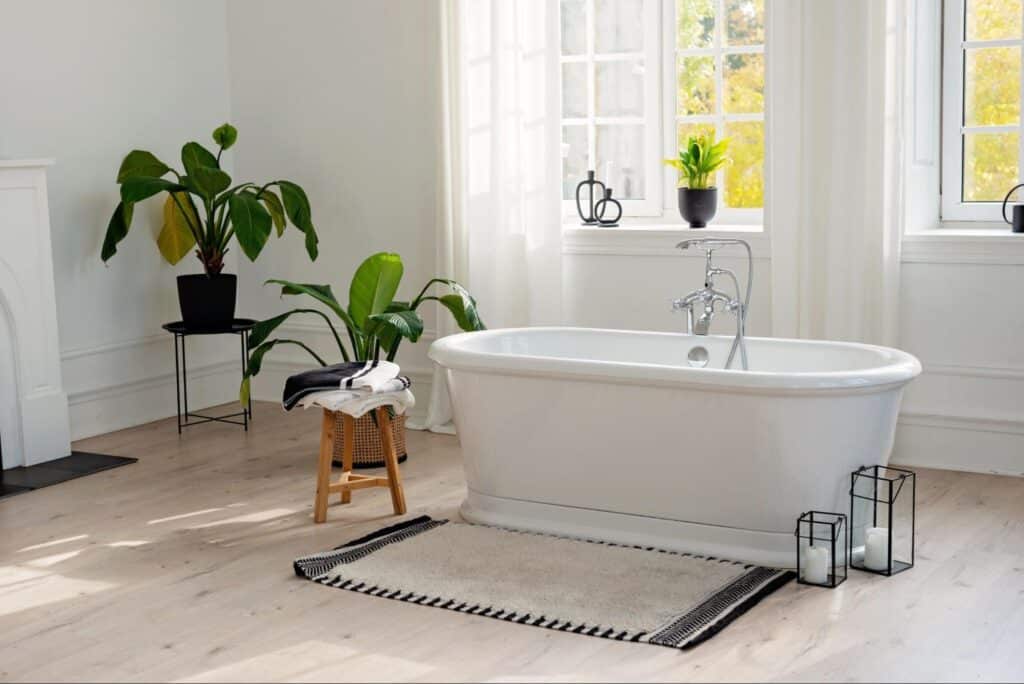
In residential settings, the advantages of radiant heating are especially pronounced:
Key Installation Areas
Bathrooms, kitchens, and basements are popular zones for in-floor heating systems. In these areas, stepping onto a warm floor immediately enhances comfort. In colder climates, full-home installations help maintain consistent temperatures throughout the house.
Personalized Comfort and Zoning
Radiant systems allow separate temperature control in different rooms or zones. Homeowners can tailor warmth according to usage patterns, focusing energy on living areas while reducing heat in less frequently occupied spaces.
Retrofitting Considerations
Retrofitting in-floor heating systems into an existing home may require removing or modifying flooring. Still, many homeowners find the benefits—reduced dust and improved energy efficiency—worth the effort. An assessment by a professional helps determine feasibility and identifies any subfloor or insulation upgrades needed.
Commercial Uses of Radiant Floor Heating
Radiant floor heating also excels in commercial settings, where efficiency and reliable performance are paramount:
Efficiency in Large Spaces
Open-plan offices, retail stores, and restaurants benefit from the uniform heat distribution characteristic of in-floor heating systems. Traditional forced-air solutions can leave some areas too cold or too hot, while radiant flooring delivers consistent, comfortable warmth across large spaces. The silent operation is an additional advantage, promoting a peaceful work environment.
Customization and Zoning for Business Needs
Commercial installations frequently involve multiple heating zones. Different sections of a building can be managed independently, optimizing energy use based on occupancy and operational hours. These low-maintenance systems help minimize disruptions—a significant consideration for businesses.
Installation Process and Timeline
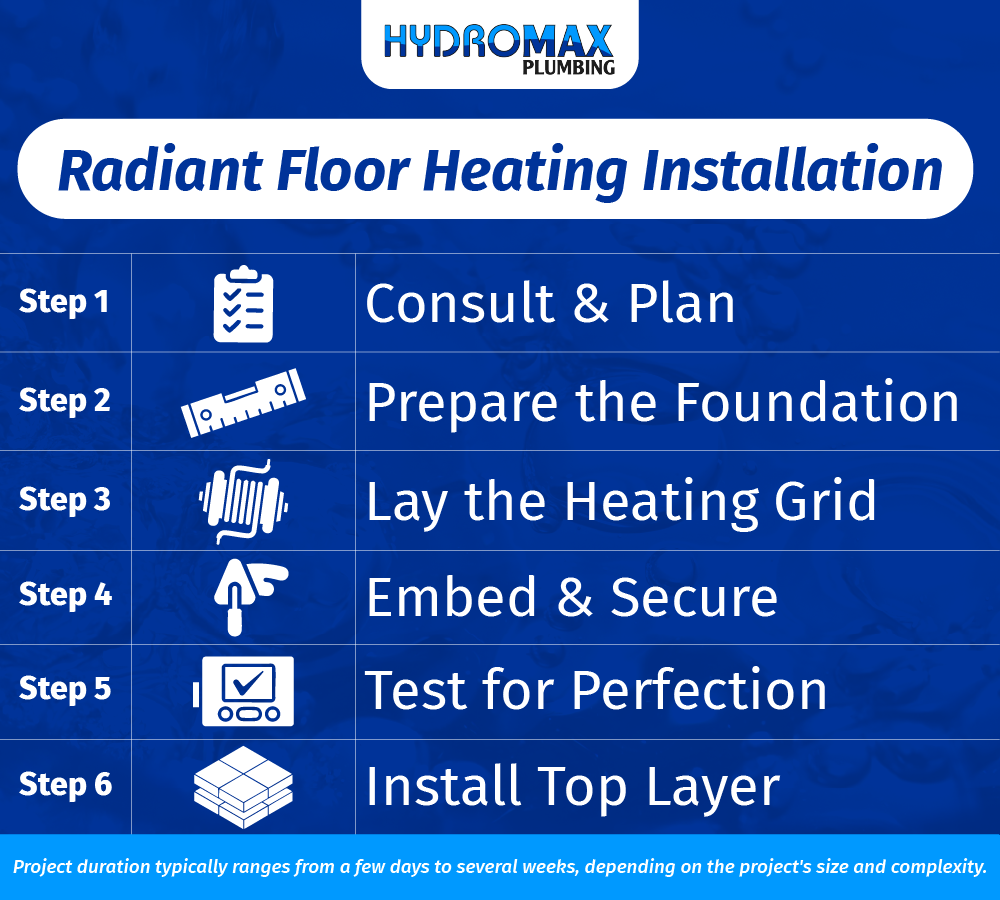
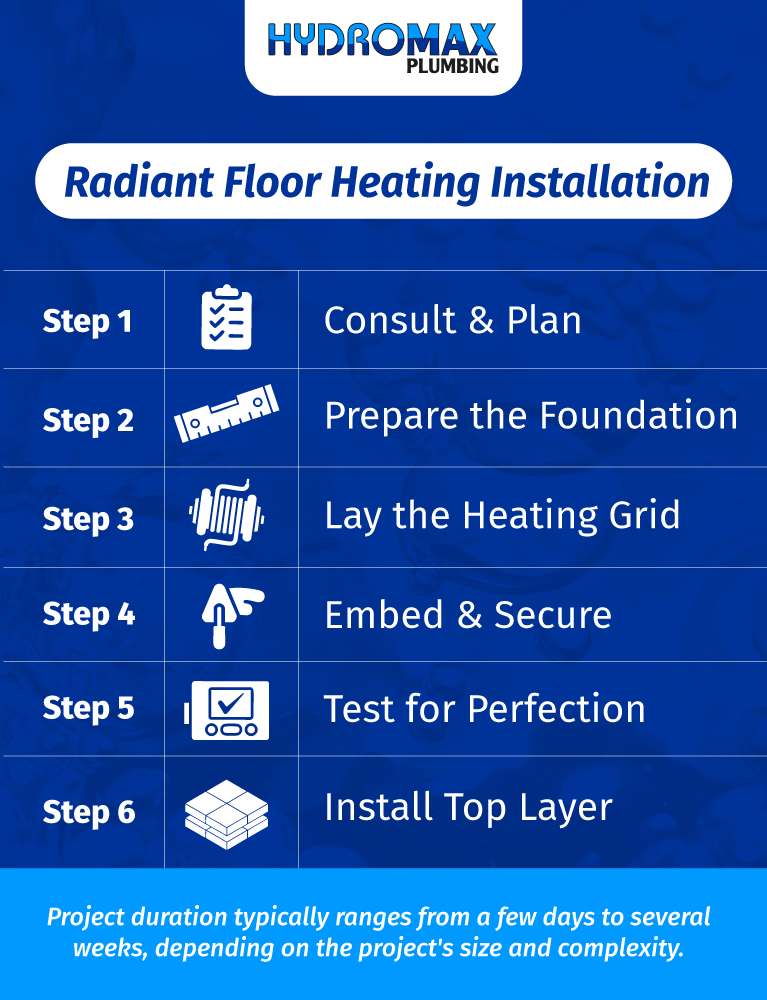
Installing an in-floor heating system is a multifaceted process requiring careful design and planning—a specialty the team at Hydromax Plumbing has perfected:
Pre-Installation Assessment
A professional assessment is conducted to measure and evaluate the space, as well as review existing insulation. Choosing between electric and hydronic depends on factors like system size, budget, and expected energy consumption. Any necessary subfloor or insulation improvements are identified at this stage.
Installation Steps
- Subfloor Preparation: The floor is cleaned and leveled. Removing outdated flooring materials may be necessary to achieve a flat work surface.
- Laying the Heating Elements: Heating cables or hydronic tubing is arranged according to a design plan that optimizes heat distribution.
- Embedding and Covering: A layer of concrete, gypsum, or compatible flooring substrate is used in wet installations. Dry installations sandwich heating elements between subfloor layers.
- System Testing: The system undergoes thorough testing to verify even heat output and correct functionality.
- Final Finishing Touches: The top layer—floor tiles, hardwood, or another surface—is installed. The result is a sleek, comfortable, and discrete heating solution.
Depending on the scale of the project, the full process may range from several days to weeks. Commercial projects with larger footprints require careful scheduling to avoid disruptions, while residential tasks may be phased in room-by-room sequences for convenience.
Maintenance and Longevity
With proper care, in-floor heating systems are exceptionally durable, often lasting for decades. The key to this longevity lies in routine maintenance, which differs significantly between hydronic and electric systems.
Routine Inspections and Servicing
Professional inspections catch minor issues before they escalate into costly repairs.
For Hydronic Systems (Annual Service Recommended):
Hydronic systems have several mechanical components that benefit from an annual professional tune-up to ensure they operate safely and efficiently. A typical service includes:
- Boiler/Water Heater Inspection: The technician will check the boiler’s ignition and safety controls, clean burners, inspect for leaks, and ensure the heat exchanger is functioning correctly to maximize efficiency.
- System Pressure Check: The system’s water pressure is checked and adjusted. Low pressure can lead to poor heat circulation and indicates a potential leak.
- Pump and Valve Function: The circulator pumps are inspected for unusual noises or vibrations that could signal future failure. All zone valves and shut-offs are checked to ensure they operate correctly.
- Manifold and Tubing Integrity: The distribution manifold is inspected for leaks or corrosion. The technician will also bleed any trapped air from the system, as air pockets can create cold spots and reduce performance.
- Fluid Quality Check: In systems using a glycol mix (antifreeze), the fluid concentration and pH levels are tested to prevent corrosion and ensure freeze protection.
For Electric Systems (Minimal Maintenance):
Electric systems are renowned for being virtually maintenance-free. There are no moving parts, boilers, or water to manage. Routine checks are simple and can often be done by the homeowner:
- Thermostat Functionality: Regularly ensure the thermostat is communicating correctly with the heating elements.
- Visual Inspection: Periodically check that there is no damage to the flooring above that could impact the system embedded below.
Best Practices for Longevity
Beyond professional servicing, you can extend your system’s life with these simple practices:
- Keep the System Clean: During any renovations, ensure the floor and heating elements (if exposed) are protected from construction debris, screws, or nails.
- Monitor Energy Usage: A sudden, unexplained spike in your energy bill could indicate an underlying issue with your system that needs professional attention.
- Schedule Professional Servicing: While electric systems require minimal oversight, scheduling annual service for your hydronic system with a qualified technician is the single best way to ensure efficiency, prevent costly failures, and maximize its lifespan.
Think of maintenance not as a cost, but as an investment in performance. A well-maintained hydronic system will reward you with decades of reliable, efficient warmth. Should you notice any issues, like cool spots or unusual noises, addressing them promptly will keep your system running smoothly for years to come.
Comparing In-Floor Heating Systems with Traditional Heating Systems
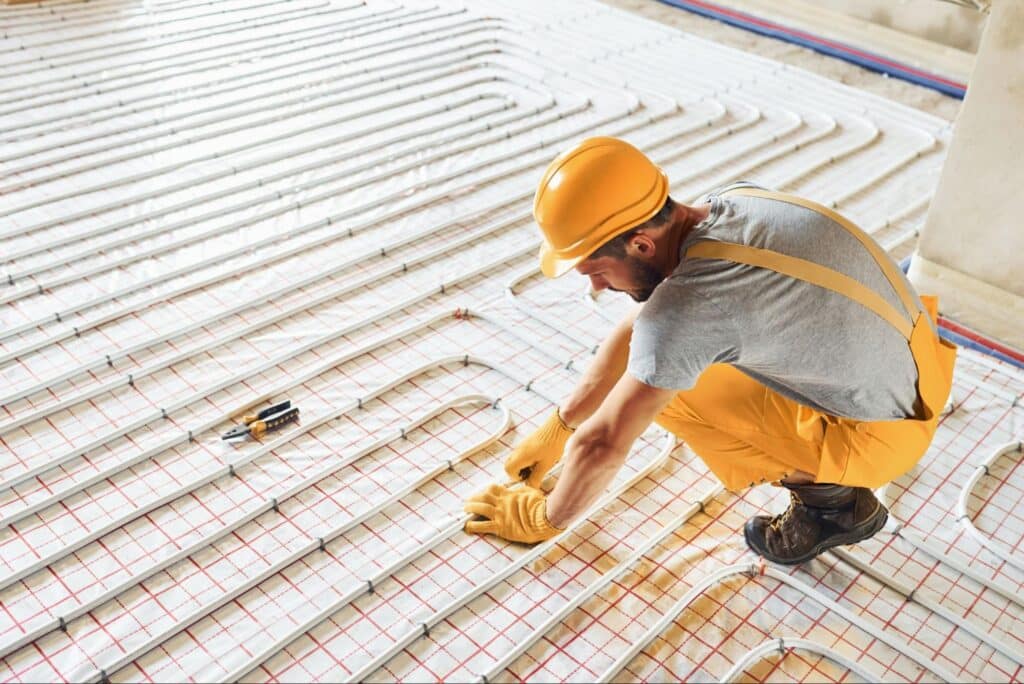
When choosing a heating solution, the differences between radiant and traditional forced-air models are stark.
- Efficiency and Comfort: As detailed in the advantages, radiant systems deliver superior comfort through even, floor-up heat distribution, eliminating the cold spots and drafts common with forced-air systems. This allows rooms to feel comfortable at a lower thermostat setting, saving energy.
- Air Quality and Noise: Radiant heat provides a significant air quality advantage by not circulating dust and allergens. Furthermore, its silent operation creates a more peaceful environment compared to the noise from furnaces and air handlers.
Emerging Trends and Future Innovations
In-floor heating systems continue to evolve, influenced by technological advancements and sustainability goals:
Smart Home Integration
Modern systems are increasingly compatible with automation and remote control, allowing homeowners to optimize energy use by programming temperature settings to match daily routines. Smartphone apps and voice-activated assistants further streamline temperature adjustments.
Renewable Energy Compatibility
Integrating radiant heating with solar thermal panels or geothermal systems aligns with a growing emphasis on clean energy. Such systems can reduce reliance on fossil fuels while further improving overall efficiency.
Advanced Materials and Installation Techniques
Advancements in heating element technology and installation methods are making in-floor heating systems more accessible and versatile. This includes thin, peel-and-stick mats for electric installations, and hydronic tubing that can be laid in a single, continuous run. These innovations facilitate simpler, more cost-effective installations.
Considering Future Energy Trends
Designing in-floor heating systems to work with renewable energy sources helps ensure a future-proof heating solution. This proactive approach can result in sustained energy savings, particularly where incentive programs support efficiency upgrades.
A Smarter, More Comfortable Way to Heat Your Floor
In-floor heating systems offer a modern, versatile alternative to traditional heating solutions. By delivering silent, even warmth directly underfoot, it enhances comfort, improves air quality, and offers significant long-term energy efficiency. Whether for the luxurious feel in a residential bathroom or the reliable performance across a large commercial space, it is a forward-thinking investment in your property. While the choice between an electric or hydronic system depends on your specific needs, the result is a modern heating solution that adds tangible value and appeal.
If you’re ready to move beyond drafts and cold spots, contact Hydromax Plumbing today to learn more about our radiant floor heating option. Our experts will guide you through every step—from system design and installation to long-term maintenance—to ensure your property benefits from the ultimate in comfort and efficiency.


